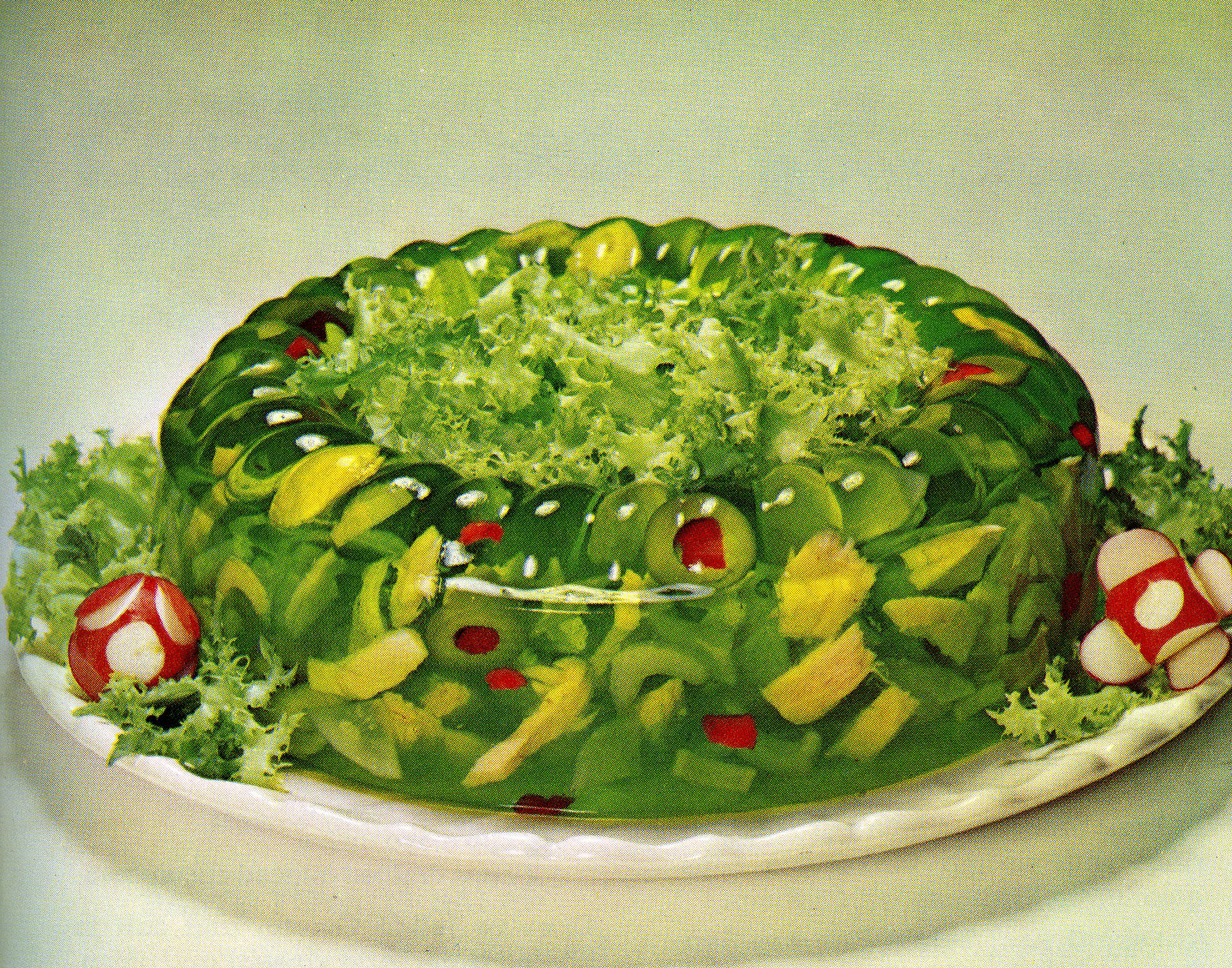
From “Joys of Jell-O,” circa 1960s.
The Special Collections Research Center recently acquired a unique collection – the Cookbooks and cooking pamphlets collection, which consists of numerous cooking pamphlets and booklets sponsored by a plethora of companies that span the entirety of the 20th century. These pamphlets are a particularly interesting and intersectional research resource, as they highlight the growth of American food culture, as well as its intersections with race, gender, class, and post-war capitalism. As the processor assigned with the joyful task of arranging and describing these fascinating items, a theme appeared to me – gelatin (or gelatine, as it was then spelled.) A few of these items are solely focused on the wonders of cooking with gelatin, or in perhaps its most famous form, Jell-O. Most of the pamphlets contain at least a few gelatin-focused recipes, and often showcase how one can make gelatin treats using their own brand of food.
In pondering this singular Jell-O tunnel vision, I recalled how my own grandmother – who lived through the Great Depression and World War II – herself always had a mold of Jell-O available for dessert in her fridge, well into her eighties. This apparent obsession with gelatin by the American public of the 1950s and 1960s made me curious to find out more, and just why one would ever desire to make a Ring-Around the Tuna or Jellied Chicken Loaf (see below for recipes.)
Though gelatin went through a kind of Renaissance in the 1950s and 60s, it had been a popular food for a few centuries by that point. Due to the way gelatin was made (by rendering collagen from animal bones), it was a time-consuming and difficult process, and ultimately ended in refrigeration of some kind, which the average person did not have in their home. Therefore, gelatin was a status symbol – if you could afford to have an aspic or jelly jiggling on your table at dinnertime, you were one wealthy sonofagun. When refrigeration became popular and readily available to the masses in the 20th century, this changed some. However, it was truly the invention of instant gelatin that changed the Jell-O game with, you got it – Jell-O!

From “Dishes Men Like,” 1952.
The highest-selling prepared dessert in the world, Jell-O – or instant gelatin – was created in 1897, but it wasn’t until 1902 when Jell-O began its journey to becoming a household name, as well as a name synonymous with any kind of gelatin. Taking over the gelatin market went very well for Jell-O post-World War II, as women returned to the home and suburban sprawl-gender norms began to kick in – more specifically, THESE LADIES NEEDED TO COOK FOR THEIR MEN.
Enter Jell-O, whose timing, according to an article by Sarah Grey,
“…couldn’t have been better. Jell-O tapped into one of the biggest culinary currents of the era: domestic science, also known as home economics. Food historian Laura Shapiro…explains that, around the turn of the century, many women in the emerging American middle class began linking the changes brought into their homes by industrialization and scientific advances…to the domestic work they performed every day and re-imagining housework. This spirit of domestic reform embraced efficiency, purity, cleanliness, and order.
“Instant gelatin fit the bill. It was fast, unlike the traditional method of making gelatin. It was economical: A housewife could stretch her family’s leftovers by encasing them in gelatin. And, since sugar was already included in the flavored mixes, the new packaged gelatins didn’t require cooks to use up their household stores of sugar…
“Industrial foods were often cheaper, and they definitely saved time. This, then, was the advertisers’ angle: Busy wives, caught up with children, housework, and, increasingly, paid employment, could whip up dinner in a jiffy, with hardly any work at all! No longer would they be chained to the stove.”

“Joys of Jell-O,” circa 1960s.
Thus, the creativity of gelatin-cooking housewives went full blast. Here are a sample of recipe names from the pamphlets in the collection: 7-Up Cheese Aspic (see image), Cherry Cola Mold (Joys of Jell-O), and “No Bake” Orange Pie (Carnation’s Failure-Proof Recipes), among many, many others. Nowadays, the Jell-O craze has waned a bit, but you can still find colorful cups of pre-made and boxed gelatin in supermarkets everywhere. Who knows, maybe Jell-O’s true heyday is yet to come!

From “You’re really Cooking when you’re cooking with Seven-Up!” 1957.
Citations
“Carnation’s Failure-Proof Recipes” pamphlet – Carnation Company, 1956, Cooking and cooking pamphlets collection, C0320, Box 3, Folder 26, Special Collections Research Center, George Mason University Libraries.
“Dishes Men Like,” pamphlet – Lea and Perrins, Inc., 1952, Cookbooks and cooking pamphlets collection, C0320, Box 3, Folder 12, Special Collections Research Center, George Mason University Libraries.
“Joys of Jell-O” pamphlet – General Foods Corporation, circa 1960s, Cookbooks and cooking pamphlets collection, C0320, Box 5, Folder 17, Special Collections Research Center, George Mason University Libraries.
“You’re really Cooking when you’re cooking with Seven-Up!” pamphlets (2) with insert – Seven-Up, Co., 1957, C0320. Box 4, Folder 7, Special Collections Research Center, George Mason University Libraries.
Sources
https://whatscookingamerica.net/History/Jell-0-history.htm
https://www.seriouseats.com/2015/08/history-of-jell-o-salad.html
https://www.thedailymeal.com/eat/why-were-there-so-many-gelatin-based-dishes-50s-and-60s
Follow Special Collections Research Center on Social Media at our Facebook, Instagram, and Twitter accounts. To search the collections held at Special Collections Research Center, go to our website and browse the finding aids by subject or title. You may also e-mail us at speccoll@gmu.edu or call 703-993-2220 if you would like to schedule an appointment, request materials, or if you have questions. Appointments are not necessary to request and view collections.

